About six-in-ten in fact feel linked to assorted Asians in the U.S.
Pew Review Center performed this prognosis to love the rich diversity of parents of Asian initiating keep or ancestry residing in the United States and their views of identity. The gaze is section of the Center’s multiyear, comprehensive, in-depth quantitative and qualitative compare effort centered on the nation’s Asian inhabitants. Its centerpiece is that this nationally representative gaze of seven,006 Asian adults exploring the experiences, attitudes and views of Asians residing in the U.S. The gaze sampled U.S. adults who self-title as Asian, both alone or in aggregate with assorted races or Hispanic ethnicity. It changed into provided in six languages: Chinese (Simplified and Archaic), English, Hindi, Korean, Tagalog and Vietnamese. Responses were calm from July 5, 2022, to Jan. 27, 2023, by Westat on behalf of Pew Review Center.
The Center recruited a mountainous sample to stare the diversity of the U.S. Asian inhabitants, with oversamples of the Chinese, Filipino, Indian, Korean and Vietnamese populations. These are the 5 biggest initiating keep groups amongst Asian Americans. The gaze additionally features a mountainous ample sample of self-diagnosed Jap adults, making findings about them reportable. In this document, the six biggest ethnic groups include these that title with one Asian ethnicity easiest, both alone or in aggregate with a non-Asian speed or ethnicity. Collectively, these six groups constitute 81% of all U.S. Asian adults, essentially based on a Pew Review Center prognosis of the Census Bureau’s 2021 American Community Watch (ACS), and are the six groups whose attitudes and opinions are highlighted all the plot in which thru the document. Watch respondents were drawn from a nationwide sample of residential mailing addresses, which included addresses from all 50 states and the District of Columbia. Genuinely perfect surnames list frames maintained by the Marketing and marketing Systems Community were extinct to complement the sample. These eligible to total the gaze were provided the different to make so on-line or by mail with a paper questionnaire. For more microscopic print, leer the Methodology. For questions extinct in this prognosis, leer the Topline Questionnaire.
The gaze compare plan and questionnaire were reviewed and licensed by Westat’s institutional assessment board (IRB), which is an exterior and fair committee of experts that specialize in protecting the rights of compare contributors.
Even supposing the U.S. Asian inhabitants changed into the quickest rising racial and ethnic workforce in the nation from 2000 to 2019, it’s miles calm a reasonably microscopic inhabitants. In accordance with the 2021 American Community Watch, the nation’s Asian inhabitants constitutes 7% of the U.S. inhabitants (of all ages) and 7% of adults (these ages 18 and older).
Pew Review Center designed this gaze with these microscopic print in mind to be as inclusive as likely of the diversity of Asian American experiences. Even so, gaze compare is dinky in terms of documenting the views and attitudes of the less populous Asian initiating keep groups in the U.S. To take care of this, the gaze changed into complemented by 66 pre-gaze level of interest groups of Asian adults, performed from Aug. 4 to Oct. 14, 2021, with 264 recruited contributors from 18 Asian initiating keep groups. Focal level workforce discussions were performed in 18 assorted languages and moderated by members of their initiating keep groups.
Findings for less populous Asian initiating keep groups in the U.S., these that are no longer amongst the six biggest Asian initiating keep groups, are grouped below the category “Other” in this document and are included in the overall Asian adult findings in the document. These ethnic initiating keep groups each originate up about 2% or less of the Asian inhabitants in the U.S., making it spirited to recruit nationally representative samples for each initiating keep workforce. The workforce “Other” includes these that title with one Asian ethnicity easiest, both alone or in aggregate with a non-Asian speed or Hispanic ethnicity. Findings for these that title with two or more Asian ethnicities are no longer offered by themselves in this document however are included in the overall Asian adult findings.
To learn more about how members of less populous Asian initiating keep groups in the U.S. title, leer the quote sorter per our level of interest workforce discussions. There, it’s likely you’ll maybe maybe maybe possibly read how contributors characterize their identity in their very own words.
For this prognosis, an further nationwide gaze of 5,132 U.S. adults changed into performed from Dec. 5 to 11, 2022, the utilization of Pew Review Center’s American Inclinations Panel. The gaze of U.S. adults changed into performed in English and Spanish. Respondents are recruited thru nationwide, random sampling of residential addresses.
Pew Review Center has performed plenty of compare that focal level on Asian Americans. Outdated demographic compare examined the diversity of origins, key details, and rising earnings inequality amongst Asians residing in the U.S. and key findings about U.S. immigrants. Qualitative compare possess centered on what it formulation to be Asian in The United States as well to barriers to English language studying amongst Asian immigrants. Outdated surveys possess centered on concerns over discrimination and violence against Asian Americans, as well to compare about their spiritual beliefs. Gain these publications and more on the Center’s Asian Americans subject page.
Pew Review Center is a subsidiary of The Pew Charitable Trusts, its major funder. The Center’s Asian American portfolio changed into funded by The Pew Charitable Trusts, with beneficiant enhance from The Asian American Foundation; Chan Zuckerberg Initiative DAF, an told fund of the Silicon Valley Community Foundation; the Robert Picket Johnson Foundation; the Henry Luce Foundation; the Doris Duke Foundation; The Wallace H. Coulter Foundation; The Dirk and Charlene Kabcenell Foundation; The Prolonged Family Foundation; Lu-Hebert Fund; Gee Family Foundation; Joseph Cotchett; the Julian Abdey and Sabrina Moyle Charitable Fund; and Nanci Nishimura.
We would additionally desire to thank the Leaders Dialogue board for its plan leadership and precious assist in serving to originate this gaze likely.
The strategic communications marketing campaign extinct to promote the compare changed into made likely with beneficiant enhance from the Doris Duke Foundation.
The terms Asian, Asians residing in the United States, U.S. Asian inhabitants and Asian Americans are extinct interchangeably all the plot in which thru this document to consult with U.S. adults who self-title as Asian, both alone or in aggregate with assorted races or Hispanic identity.
Ethnicity and ethnic initiating keep labels, comparable to Chinese and Chinese initiating keep, are extinct interchangeably in this document for findings for ethnic initiating keep groups, comparable to Chinese, Filipino, Indian, Jap, Korean or Vietnamese. For this document, ethnicity isn’t any longer nationality. As an instance, Chinese in this document are these self-identifying as of Chinese ethnicity, reasonably than essentially being a present or extinct citizen of the Other folks’s Republic of China. Ethnic initiating keep groups in this document include these that self-title as one Asian ethnicity easiest, both alone or in aggregate with a non-Asian speed or ethnicity.
Less populous Asian initiating keep groups in this document are these that self-title with ethnic initiating keep groups that are no longer amongst the six biggest Asian initiating keep groups. The timeframe includes these that title with easiest one Asian ethnicity. These ethnic initiating keep groups each signify about 2% or less of the overall Asian inhabitants in the U.S. As an instance, these that title as Burmese, Hmong or Pakistani are included in this category. These groups are unreportable on their very own as a consequence of microscopic sample sizes, however collectively they’re reportable below this category.
The terms Asian origins and Asian initiating keep groups are extinct interchangeably all the plot in which thru this document to characterize ethnic initiating keep groups.
Immigrants in this document are these that were no longer U.S. citizens at initiating – in assorted words, these born exterior the U.S., Puerto Rico or assorted U.S. territories to of us who’re no longer U.S. citizens. Immigrant, first expertise and foreign born are extinct interchangeably to consult with this workforce.
Naturalized citizens are immigrants who’re perfect eternal residents who possess fulfilled the length of stay and diverse requirements to alter into U.S. citizens and who possess taken the oath of citizenship.
U.S. born refers to folks born in the 50 U.S. states or the District of Columbia, Puerto Rico or assorted U.S. territories.
2d expertise refers to folks born in the 50 states or the District of Columbia, Puerto Rico or assorted U.S. territories and not using a longer decrease than one first-expertise (immigrant) parent.
Third or elevated expertise refers to folks born in the 50 states or the District of Columbia, Puerto Rico or assorted U.S. territories with both oldsters born in the 50 states, D.C., Puerto Rico or assorted U.S. territories.
The nation’s Asian inhabitants is immediate rising and diverse. Numbering more than 23 million, the inhabitants has ancestral roots all the plot in which thru the mountainous, ethnically and culturally rich Asian continent. For Asians residing in the United States, this diversity is mirrored in how they characterize their very own identity. In accordance with a brand unique, nationwide, comprehensive gaze of Asian adults residing in the U.S., 52% affirm they most most steadily exhaust ethnic labels that mirror their heritage and family roots, both alone or alongside with “American,” to characterize themselves. Chinese or Chinese American, Filipino or Filipino American, and Indian or Indian American are examples of these variations.
There are assorted ways wherein Asians residing in the U.S. characterize their identity. About half of (51%) of Asian adults affirm they exhaust American by itself (10%), alongside with their ethnicity (25%) or alongside with “Asian” as Asian American (16%) when describing their identity, highlighting their links to the U.S.
And while pan-ethnic labels comparable to Asian and Asian American are regularly extinct to characterize this diverse inhabitants broadly, the unique gaze displays that after describing themselves, appropriate 28% exhaust the designate Asian (12%) by itself or the designate Asian American (16%).
The gaze additionally finds that assorted labels are extinct by Asian Americans. Some 6% affirm they most most steadily desire regional terms comparable to South Asian and Southeast Asian when describing themselves.
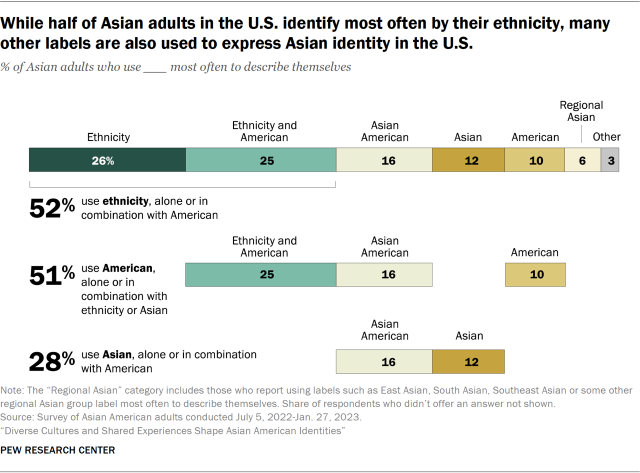
Asian adults leer more cultural differences than commonalities all the plot in which thru their workforce as successfully. When requested to make a call from two statements – that Asians in the U.S. half a frequent culture, or that Asians in the U.S. possess many totally different cultures – virtually all (90%) affirm U.S. Asians possess many totally different cultures. Merely 9% affirm Asians residing in the U.S. half a frequent culture. This peep is broadly held all the plot in which thru many demographic groups amongst Asian Americans, essentially based on the gaze.
The peep that Asian Americans possess many totally different cultures is additionally one held by the frequent public, essentially based on one more Pew Review Center gaze of U.S. adults, performed in December 2022. Among all U.S. adults, 80% affirm Asians in the U.S. possess many totally different cultures, while 18% affirm they half a frequent culture.1
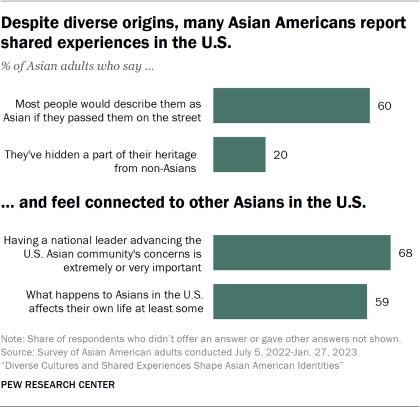
Although Asian Americans’ identities mirror their diverse cultures and origins, Asian adults additionally document certain shared experiences. A majority (60%) affirm most of the individuals would characterize them as “Asian” while walking past them on the avenue, indicating most Asian adults in fact feel they’re seen by others as a single workforce, despite the inhabitants’s diversity. One-in-5 affirm they’ve hidden a section of their heritage (their ethnic meals, cultural practices, ethnic clothing or spiritual practices) from others who’re no longer Asian, in some conditions out of fear of embarrassment or discrimination. Notably, Asian adults ages 18 to 29 are more inclined to insist they’ve done this than Asians 65 and older (39% vs. 5%).
Asian adults in the U.S. additionally in fact feel linked with assorted Asian Americans. About six-in-ten (59%) affirm that what happens to Asians in the U.S. affects their very own lives, no longer decrease than to some degree.2 And about two-thirds (68%) of Asian Americans affirm it’s miles amazingly or crucial to possess a nationwide chief advocating for the troubles and desires of the Asian inhabitants in the U.S.
The unique gaze additionally displays that mountainous majorities of Asian adults half an identical views on what it takes to be plan of in fact American. They assuredly take into fable a lot of the same components to be indispensable in their views of the American dream.
These are amongst the major findings from Pew Review Center’s unique gaze of Asian American adults, performed by mail and on-line from July 5, 2022, to Jan. 27, 2023. Right here is the biggest nationally representative gaze of its form up to now that centered on Asian Americans. The gaze changed into performed in English and 5 Asian languages, amongst a representative sample of seven,006 Asian adults residing in the United States.
Asian Americans are 7% of the U.S. inhabitants, essentially based on a Pew Review Center prognosis of the 2021 American Community Watch. Their inhabitants is diverse, with roots in more than 20 countries in East Asia, Southeast Asia and the Indian subcontinent. About 54% of the nationwide Asian inhabitants are immigrants. The six biggest initiating keep groups (Chinese, Filipino, Indian, Jap, Korean and Vietnamese), a degree of interest of this gaze and document, together fable for Seventy 9% of all Asian Americans.
Overall, about 34% of Asian Americans are the U.S.-born kids of immigrant oldsters, and one more 14% are of third or elevated expertise (that formulation their oldsters were born in the U.S. as successfully), essentially based on a Pew Review Center prognosis of the 2022 Recent Population Watch, March Annual Social and Financial Complement.
This gaze and document level of interest on Asian adults in the U.S. The six biggest initiating keep groups together fable for 81% of Asian adults. And 68% of Asian American adults are immigrants, essentially based on Center prognosis of the 2021 American Community Watch. Additionally, 25% are the U.S.-born kids of immigrant oldsters and 10% are of third or elevated expertise, essentially based on Center prognosis of authorities files.
The making of Asian American identity and files of Asian historical past in the U.S.
The pan-ethnic timeframe “Asian American” emerged in Berkeley, California, in the 1960s as section of a political plug to put together the a variety of U.S. Asian inhabitants. The advent of an Asian American identity changed into in reaction to a long historical past of exclusion of Asians in the nation, at the side of the 1882 Chinese Exclusion Act and a pair of Supreme Court docket conditions in the 1920s clarifying that Asians, at the side of South Asians, are no longer “free White persons” and as a consequence of this fact were excluded from turning into naturalized U.S. citizens.3 Subsequently, the timeframe changed into adopted by the federal authorities and at this time time is the major identity designate extinct by media, teachers, researchers and others to characterize at this time time’s diverse Asian American inhabitants.
In most conditions at this time time, somebody is assumed of Asian or Asian American if they self-title as such. But Asian Americans make no longer essentially agree on which regional or ethnic groups from the Asian continent they take into fable to be Asian, essentially based on the unique gaze. The overwhelming majority of Asian adults affirm they take into fable these from East Asia, comparable to Chinese or Koreans (89%); Southeast Asia, comparable to Vietnamese or Filipinos (88%); and to a lesser extent South Asia comparable to Indians or Pakistanis (67%) to be Asian.
But Asian adults are split on whether or no longer they take into fable Central Asians comparable to Afghans or Kazakhs to be Asian (43% of Asian adults affirm they’re). While about half of of Indian adults (56%) affirm they would include Central Asians in the category Asian, fewer than half of of Filipino (40%), Chinese (39%), Jap (34%), Korean (32%) and Vietnamese (30%) adults be aware of them Asian.
Few Asians affirm they’re educated about U.S. Asian historical past
Asian Americans possess a long historical past in the United States. From Chinese laborers who helped assemble the first transcontinental railroad, to Jap immigrants who arrived as plantation employees in what’s now the insist of Hawaii, to the incarceration of Jap Americans all the plot in which thru World War II, to Filipinos being handled as U.S. nationals while the Philippines changed into a U.S. territory, the Asian American ride has been a section of U.S. historical past.
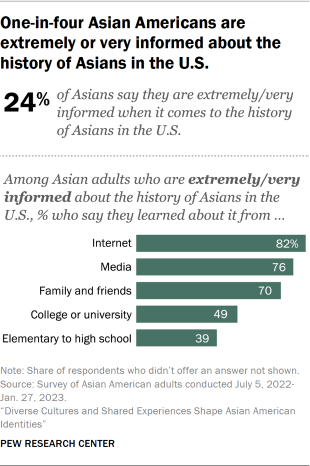
With the passage of the landmark Immigration and Nationality Act of 1965, a brand unique wave of immigrants from Asia began arriving in the United States, increasing a brand unique, as much as the moment U.S. Asian historical past. The Vietnam War and diverse conflicts in Southeast Asia introduced Vietnamese and diverse Southeast Asian refugees to the U.S., first with the passage of the 1975 Indochina Migration and Refugee Help Act after which with the Refugee Act of 1980. The 1990 Immigration Act raised immigration ceilings and space in insist processes that allowed the flows of Asian immigrants, particularly of high-expert immigrants, to continue and enhance. The U.S. expertise hiss of the Nineties and 2000s attracted many high-expert immigrants, particularly from India and China, to tech products and companies all the plot in which thru the nation.
This rich historical past, nonetheless, is minute-identified to Asian adults, essentially based on the unique gaze. One-in-four (24%) affirm they’re very or extremely told about historical past of Asians in the United States, while an equal half (24%) affirm they’re minute or on no account told.
The bulk of these very or extremely told about the historical past of Asians in the U.S. affirm they realized about this historical past thru informal channels: internet (82%), media (76%) and family and mates (70%). In distinction, 49% realized about it from college or university classes and 39% from elementary thru high college.
Immigrant ties form Asian Americans’ identities and their lifestyles in the U.S.
Immigration experiences, connections with house countries, and how long somebody has lived in the U.S. form many Asian Americans’ identities. Among Asian adults in the U.S., immigrants are more likely than these that are U.S. born to characterize their identity most most steadily with their ethnic labels, both alone or alongside with the designate American (56% vs. 41%).
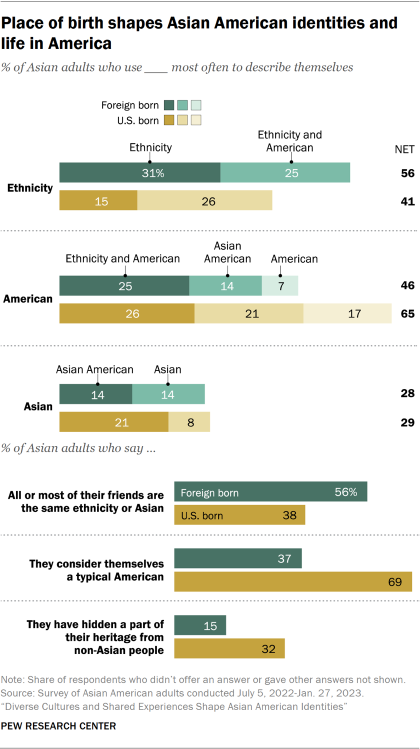
Within the meantime, Asian immigrants are less likely than U.S.-born Asians (46% vs. 65%) to insist they most most steadily characterize themselves as American in some formulation – whether or no longer by their ethnic designate mixed with American, as Asian American, or merely as American. Silent, virtually half of of Asian immigrants characterize themselves in indubitably any such three ways.
By formulation of identifying with the designate Asian – both alone or as Asian American – immigrant and U.S.-born Asians are about equally inclined to insist they make so (28% and 29% respectively). Immigrant Asians are less likely than U.S.-born Asians to title most most steadily as Asian American (14% vs. 21%).
On the ask of seeing themselves more as a “same old American” or “very assorted from a same old American,” Asian immigrant adults are a long way less likely than these born in the U.S. to believe themselves as a same old American (37% vs. 69%).
Nativity is additionally tied to how Asians in the U.S. bag their friendships. Other folks that immigrated to the U.S. are more inclined to possess mates who’re Asian or of the same ethnicity as them than are U.S.-born Asians (56% vs. 38%).
Asian immigrants (15%) are additionally less likely than U.S.-born Asians (32%) to possess ever hidden a section of their heritage from these that are no longer Asian. When requested in an open-ended ask to expose why they camouflage parts of their culture, some U.S.-born respondents mentioned phrases comparable to “fear of discrimination,” “being teased” and “embarrassing.”
Views of identity amongst Asian American immigrants are most steadily tied to time spent in the U.S.
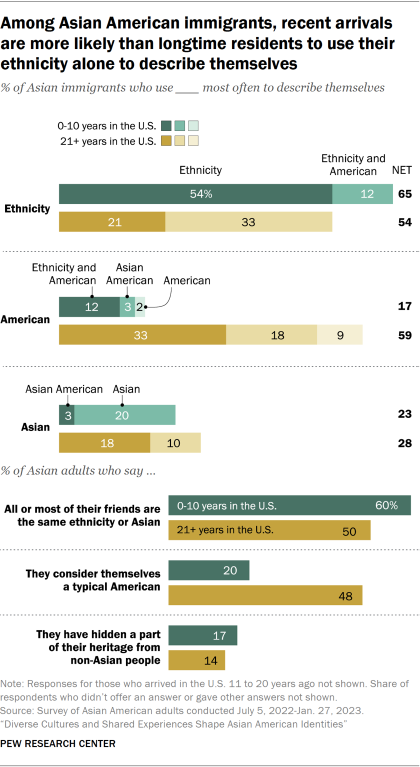
How long Asian immigrants possess lived in the U.S. additionally shapes their identity and experiences. Other folks that arrived in the U.S. previously 10 years are more likely than these that arrived more than twenty years previously to insist they most most steadily exhaust their ethnicity, comparable to Filipino or Vietnamese, to characterize themselves. And about two-thirds (65%) of these that arrived in the U.S. previously decade characterize their identity most most steadily with their ethnicity’s name, both alone or mixed with American, when put next with 54% amongst these which were in the nation for more than two a long time.
Roughly half of (54%) of these which possess arrived previously 10 years affirm they most most steadily exhaust easiest their ethnicity to characterize themselves, when put next with appropriate 21% of these that arrived more than two a long time previously who affirm the same.
On the assorted hand, appropriate 17% of Asian immigrants who arrived in the nation previously 10 years characterize themselves most most steadily as American, by their ethnic designate mixed with American, or as Asian American, while 59% of these that arrived more than twenty years previously make so.
By formulation of their circle of mates, 60% of Asian immigrants who arrived previously 10 years affirm most or all of their mates are additionally Asian Americans, while 50% of these that arrived more than twenty years previously affirm the same.
And when requested if they suspect about themselves as same old Americans or no longer, Asian immigrants who arrived in the U.S. previously decade are considerably less likely than these that arrived more than two a long time previously to insist they’re same old Americans (20% vs. Forty eight%).
The unique gaze additionally explored the views Asian Americans possess about traits that originate one “in fact American.” Overall, Asian Americans and the frequent U.S. inhabitants half an identical views of what it formulation to be American. Virtually all Asian adults and U.S. adults affirm that accepting folks of diverse racial and non secular backgrounds (94% and 91%), believing in person freedoms (92% and 94%) and respecting U.S. political establishments and laws (89% and 87%) are indispensable for being in fact American.
Equally, Asian Americans and the U.S. frequent inhabitants half in their views about the American dream. They are saying having freedom of choice in easy techniques to live one’s lifestyles (96% and 97% respectively), having a lawful family lifestyles (96% and 94%), retiring conveniently (96% and 94%) and proudly owning a house (both 86%) are indispensable to their peep of the American dream. Smaller shares of Asian and U.S. adults (30% and 27%) affirm proudly owning a trade is serious to their peep of the American dream.
Listed below are assorted gaze findings highlighting the a variety of views and attitudes of Asian adults residing in the U.S.:
- Indian adults are the most likely of the six biggest Asian initiating keep groups to insist they most most steadily exhaust their ethnicity, with out the addition of “American,” to characterize themselves. About four-in-ten Indian adults (41%) affirm they make this. By comparability, smaller shares of Korean (30%), Filipino (29%), Chinese (26%) and Vietnamese (23%) adults make the same. Jap adults (14%) are the least likely amongst the biggest groups to exhaust their ethnic identity timeframe alone.
- Jap adults are the least likely amongst the biggest Asian initiating keep groups to insist they’ve friendships with assorted Asians. About one-in-three Jap adults (34%) affirm most or all their mates half their very own ethnicity or are in any other case Asian. By distinction, about half of of all Indian (55%), Vietnamese (55%), Chinese (51%), Korean (50%) and Filipino (Forty eight%) respondents affirm the same.
- One-in-four Korean adults (25%) affirm they’ve hidden section of their heritage from these that are no longer Asian. Some 20% of Indian, 19% of Chinese, 18% of Vietnamese, 16% of Filipino and 14% of Jap adults affirm they’ve done the same.
- Across the biggest ethnic groups, about half of or more affirm that what happens to Asians in the U.S. affects what happens in their very own lives. About two-thirds of Korean (67%) and Chinese (65%) adults affirm this. By comparability, 61% of Jap, 54% of Filipino, 55% of Indian and 52% of Vietnamese adults affirm they’re impacted by what happens to Asians nationally.
- Most Asian adults amongst the biggest ethnic initiating keep groups affirm a nationwide chief advancing the U.S. Asian workforce’s concerns is serious. Roughly three-in-four Filipino (74%) and Chinese (73%) adults affirm it’s miles terribly or extremely indispensable to for the U.S. Asian workforce to possess a nationwide chief advancing its concerns. A majority of Vietnamese (69%), Korean (66%), Jap (63%) and Indian adults (62%) says the same.
- About half of of Vietnamese registered voters (51%) title with or lean to the Republican Celebration. In distinction, about two-thirds of Indian (68%), Filipino (68%) and Korean (67%) registered voters title with or lean toward the Democratic Celebration. And 56% of Chinese registered voters additionally affiliate with the Democratic Celebration.
